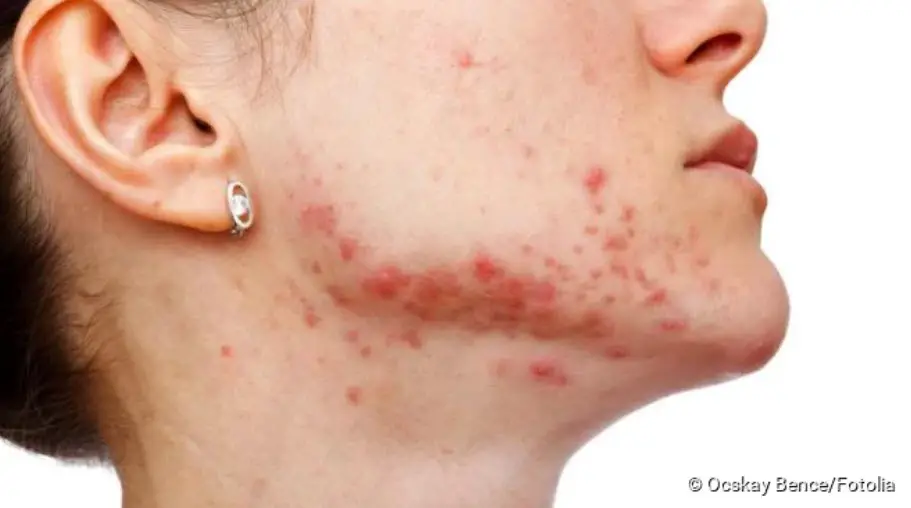Shingles in the face: causes, course, prognosis
Shingles in the face: causes, course, prognosis
Shingles in the face is relatively common and often associated with complications: The pathogen can cause damage to the eye, ear and facial nerves. In addition, unsightly scars can remain. Read more about the shingles on your face!

This is how shingles develop in the face
A shingles in the face develops in the same way as other forms of herpes zoster: the varicella zoster virus (VZV), which always causes chickenpox first, remains in the body for life after this childhood disease has healed: it “slumbers” in nerve roots of the spinal cord and cranial nerves. The immune system keeps the pathogen in an inactive state so that it does not cause any problems.
But if the body’s defenses are weakened, the viruses can “wake up” again and cause shingles: Starting from the nerve roots, the pathogens migrate along the respective nerve pathways, causing the nerve tissue to become inflamed. From the outside, this is visible in that part of the body that is supplied by the nerve tract in question. Thus, shingles affects the face, scalp and neck if the pathogens have survived in the roots of corresponding cranial nerves.
Symptoms of shingles on the face
As with other forms of zoster, shingles on the head usually causes pain and the typical skin rash. These then appear, for example, on the hairy scalp, forehead and nose or even on the neck. However, the rash may also be absent.
Because of the many sensitive structures in the head area, shingles in the face can lead to secondary problems. This is especially true when the patient’s immune system is weakened. It can be particularly problematic if herpes zoster in the face affects the eye or ear:
Shingles in the eye (Zoster ophthalmicus)
The eye is a very sensitive organ and therefore susceptible to herpes zoster. In principle, shingles in the face can affect any structure of the eye. Possible consequences are, for example:
- Conjunctivitis (inflammation of the conjunctiva)
- Inflammation of the sclera of the eye (scleritis): The porcelain white sclera forms the outermost wall layer of the eyeball (outer eye skin).
- Inflammation of the cornea of the eye (keratitis): The translucent cornea is the part of the outer skin of the eye that lies above the pupil.
- Inflammation of the middle eye skin (uveitis): The middle eye skin (uvea) consists of several components, including the iris.
- Secondary glaucoma: Dangerous increase in intraocular pressure (glaucoma) due to uveitis.
- Damage to the retina and/or optic nerve: This complication can lead to permanent blindness.
Shingles on the ear (Zoster oticus)
Shingles in the face can affect an ear or its nerve structures. Possible symptoms here are:
- Hearing disorders when the acoustic nerve is affected
- Vestibular balance disorders, if the vestibular nerve is affected
- Facial paralysis caused by an inflammation of the facial nerve: This nerve supplies, among other things, the facial muscles and runs in sections in the area of the middle and inner ear. The paralysis of the facial nerve is called facial nerve palsy.
Shingles on the face: persistent symptoms
In general, shingles on the head increases the risk of developing post-zosteric neuralgia. This means that the pain continues even after the rash has subsided, sometimes even for years. In case of shingles in the face, the trigeminal nerve is usually responsible for this persistent pain. This is also known as trigeminal neuralgia.
Shingles on the face: scarring
In addition to the symptoms mentioned, shingles often causes scarring. The face and neck area are of course particularly unfavourable regions for this. In contrast to chickenpox, the scars from shingles occur without the skin blisters being scratched open. Therefore they often cannot be prevented. However, the earlier shingles on the face is professionally treated, the lower the risk of scars.
About this text
This text complies with the requirements of medical literature, medical guidelines and current studies and has been reviewed by medical experts.
ICD codes are internationally valid codes for medical diagnoses. They can be found, for example, in doctor’s letters or on certificates of incapacity to work.
Sources
- Hacke, W.: Neurology, Springer-Verlag, 14th edition, 2016
- Behrbohm, H. et al.: Short textbook otorhinolaryngology, Georg Thieme Verlag, 2009





